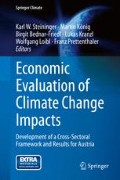Abstract
The aim of this task within the COIN framework is the preparation of the climatological information for all involved sectors for the past and the possible range of future developments. As a basis for the historical observations, products of the Austrian weather service (ZAMG) are used. The climate change scenarios are derived from 31 regional and global climate models forced with four different emission scenarios.
Impact relevant climate depending indicators have been developed and calculated from observational data and climate change scenario on a NUTS3 level. In total, 63 impact relevant indicators have been defined. The majority of the indicators are a kind of “peak over threshold” analyses like the temperature threshold heat day (Tmax ≥ 30 °C).
All climate scenarios indicate a warming within the twenty-first century. The whole ensemble indicates a warming of 0.5 up to 4 °C till 2050 and at the end of the century the warming reaches from ~2 °C up to 6 °C in winter and up to 9 °C in summer. The low border stems from models forced with the RCP 4.5 emission scenario and the high border from models forced with RCP 8.5.
The climate change signal for precipitation is not that clear. The annual sum shows no clear trend. For summer precipitation, the majority of the model indicates a decrease till −20 % and in winter an increase of the same magnitude.
The derived indicators reflect the same trends. In general, it can be said that temperature depending indicators at the middle of the century derived from the hottest realisations have a similar climate change signal as the “mid-range” scenarios at the end of the century.
Access this chapter
Tax calculation will be finalised at checkout
Purchases are for personal use only
References
Christensen JH, Carter TR, Rummukainenm M (2007) Evaluating the performance and utility of regional climate models: the PRUDENCE Project. Clim Change 81(1):1–6. doi:10.1007/s10584-006-9211-6
Formayer H (2010) Prognostizierte Klimaveränderungen in Österreich: Unsicherheiten und Bias. In: Österreichischer Wasser und Abfallwirtschaftsverband, Auswirkungen des Klimawandels auf Hydrologie und Wasserwirtschaft in Österreich, Eigenverlag des Österreichischer Wasser und Abfallwirtschaftsverband http://www.oewav.at/Page.aspx_param_target_is_135399.v.aspx 202 Seiten; ISBN: ISBN 978-3-902084-79
Haiden T, Kann A, Pistotnik G, Stadlbacher K, Wittmann C (2009) Integrated Nowcasting through Comprehensive Analysis (INCA) – system description. ZAMG report, p. 60. http://www.zamg.ac.at/fix/INCA_system.pdf>http://www.zamg.ac.at/fix/INCA_system.pdf
Hewitt C, Griggs D (2004) Ensembles-based predictions of climate changes and their impacts (ENSEMBLES). Eos 85:566
Kyselý J (2002) Temporal fluctuations in heat waves at Prague-Klementinum, the Czech Republic, in 1901–1997, and their relationships to atmospheric circulation. Int J Climatol 22:33–50
Loibl W, Züger J, Köstl M, Formayer H, Schicker I, Gobiet A, Suklitsch M, Schöner W, Anders I, Matulla C (2010) Reclip:century – a project conducting 21st century regional climate simulation runs focussing on the Greater Alpine Region, EGU General Assembly 2010, held 2–7 May, 2010 in Vienna, Austria, p. 11752
Meehl GA et al (2007) The WCRP CMIP3 multimodel dataset—a new era in climate change research. Bull Am Meteorol Soc 88:1383–1394
Meinshausen M, Smith S, et al. (2011) The RCP greenhouse gas concentrations and their extension from 1765 to 2500. Clim Change (Special Issue on RCPs)
Meissner C, Schädler G, Panitz H-J et al (2009) High-resolution sensitivity studies with the regional climate model COSMO-CLM. Meteorol Z 18(5):543–557. doi:10.1127/0941-2948/2009/0400
NUTS (2013) NUTS – Nomenclature of territorial units for statistics. http://epp.eurostat.ec.europa.eu/portal/page/portal/nuts_nomenclature/introduction
Schöner W, Dos Santos Cardoso EM (2004) Datenbereitstellung, Entwicklung von Regionalisierungstools und einer Schnittstelle zu den regionalen Klimamodellen. ZAMG Report for project year 1 PJ1. In: Loibl et al. (ed) Reclip:more – Research for climate protection: model run evaluation, 1. Jahresbericht. ARC systems research, Seibersdorf
Taylor KE, Stouffer RJ, Meehl GA (2012) An overview of CMIP5 and the experiment design. Bull Am Meteorol Soc 93:485–498. doi:10.1175/BAMS-D-11-00094.1
Tebaldi C, Knutti R (2007) The use of the multi-model ensemble in probabilistic climate projections. Philos Trans R Soc A 365:2053–2075
Themeßl M, Gobiet A, Heinrich G (2011) Empirical-statistical downscaling and error correction of daily precipitation of regional climate models and its impact on the climate change signal. Clim Change 112(2):449–468. doi:10.1007/s10584-011-0224-4
Vlcek O, Radan H (2009) Is daily precipitation gamma-distributed? Adverse effects of an incorrect use of the Kolmogorov–Smirnov test. Atmos Res 93:759–766. doi:10.1016/j.atmosres.2009.03.005
Acknowledgement
We thank the Austrian Central Institute for Meteorology and Geodynamics—ZAMG—for providing meteorological observation data. The ENSEMBLES data used in this work was funded by the EU FP6 Integrated Project ENSEMBLES (Contract number 505539) whose support is gratefully acknowledged. We acknowledge the World Climate Research Programme’s Working Group on Coupled Modelling, which is responsible for CMIP, and we thank the climate modelling groups for producing and making available their model output.
Author information
Authors and Affiliations
Corresponding author
Editor information
Editors and Affiliations
Rights and permissions
Copyright information
© 2015 Springer International Publishing Switzerland
About this chapter
Cite this chapter
Formayer, H., Nadeem, I., Anders, I. (2015). Climate Change Scenario: From Climate Model Ensemble to Local Indicators. In: Steininger, K., König, M., Bednar-Friedl, B., Kranzl, L., Loibl, W., Prettenthaler, F. (eds) Economic Evaluation of Climate Change Impacts. Springer Climate. Springer, Cham. https://doi.org/10.1007/978-3-319-12457-5_5
Download citation
DOI: https://doi.org/10.1007/978-3-319-12457-5_5
Published:
Publisher Name: Springer, Cham
Print ISBN: 978-3-319-12456-8
Online ISBN: 978-3-319-12457-5
eBook Packages: Earth and Environmental ScienceEarth and Environmental Science (R0)

